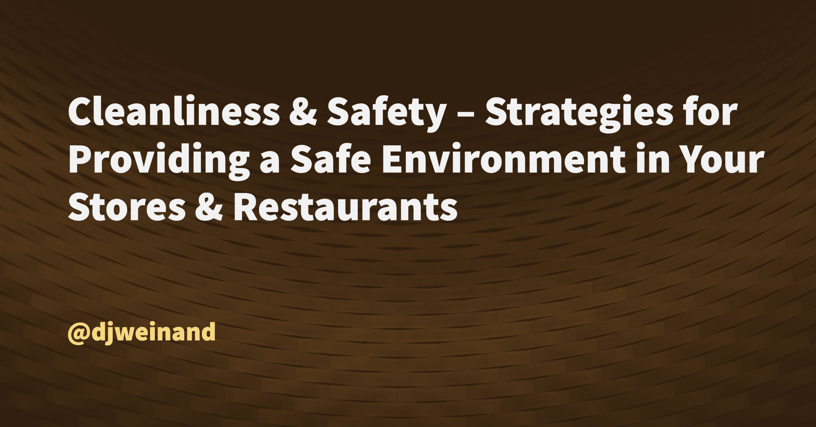In this blog, learn from leaders at Saladworks and HP what protocols will ensure a safe operating environment for both customers and employees.

Featured in This Exclusive Fireside Chat
![]() Dave. What safety protocols should be implemented as retail and restaurants begin to reopen their stores?
Dave. What safety protocols should be implemented as retail and restaurants begin to reopen their stores?
![]() Paul. Businesses are going to have to rethink entirely the way that they do business. Restaurants especially are going to have to rely on social distancing and it's going to be a real challenge. The most important thing is to make sure cleaning is done on a regular basis and through a regular cadence. Cleaning should be done at the opening of a restaurant, during the operation and at the end of the day as well. During operation, there should be cleaning events each time a user uses a particular product.
Paul. Businesses are going to have to rethink entirely the way that they do business. Restaurants especially are going to have to rely on social distancing and it's going to be a real challenge. The most important thing is to make sure cleaning is done on a regular basis and through a regular cadence. Cleaning should be done at the opening of a restaurant, during the operation and at the end of the day as well. During operation, there should be cleaning events each time a user uses a particular product.
We want to make it as easy as we can for our customers to be able to do this. Therefore, as they modify their business procedures, we are working in lockstep with them by developing the products they need for those types of protocols and environments. Our entire executive team is very serious about ensuring our products are retail-hardened so they can endure cleaning, etc.
![]() John. At the end of the day, it starts with the team. Teaching, training and ensuring that they have the tools, resources, and the plan that they need to operate safely. At Saladworks, we're working really hard to ingest all of the data that's been made available to businesses like ours. We've been leaning heavily on the national restaurant association, state and federal organizations, and other QSR fast-casual brands and retailers. As a former Walmart guy, we were taught to always look for great ideas from the industry and we've done that.
John. At the end of the day, it starts with the team. Teaching, training and ensuring that they have the tools, resources, and the plan that they need to operate safely. At Saladworks, we're working really hard to ingest all of the data that's been made available to businesses like ours. We've been leaning heavily on the national restaurant association, state and federal organizations, and other QSR fast-casual brands and retailers. As a former Walmart guy, we were taught to always look for great ideas from the industry and we've done that.
We're installing plexiglass barriers at the POS and at our soda fountains to ensure a safe operating environment. We're also reconfiguring all of our dining areas to make sure that we comply with whatever percentage of dining compliance is allowed for that market.
We've removed all of our self serve items as well, including all the condiments, utensils, lids and straws. In our dining areas, we've removed the salt & pepper and condiments. These are things that in my opinion may never come back.
Finally, on the delivery front, contactless has become a hot service offering and we've implemented protocols so that our delivery drivers can drop orders outside of people's front doors.
----
![]() Dave. What are the best practices for cleaning high-touch hardware such as POS and kiosks?
Dave. What are the best practices for cleaning high-touch hardware such as POS and kiosks?
![]() Paul. The most important thing when cleaning high-tech hardware is to make sure that you clean it as per the HP business PC / print devices cleaning guidance. This means retail and restaurant employees need to wipe and draw it across the surface slowly making sure that liquid that's on the wipe enters the equipment.
Paul. The most important thing when cleaning high-tech hardware is to make sure that you clean it as per the HP business PC / print devices cleaning guidance. This means retail and restaurant employees need to wipe and draw it across the surface slowly making sure that liquid that's on the wipe enters the equipment.
![]() John. First and foremost, retailers need to ensure store personnel understands what kind of material surface they're working with and know what finishes and casings won't tolerate certain types of cleaning chemicals.
John. First and foremost, retailers need to ensure store personnel understands what kind of material surface they're working with and know what finishes and casings won't tolerate certain types of cleaning chemicals.
I think this has actually created the necessity to adopt touchless (faucets, lights) and contactless (payments, loyalty programs) technologies and those retailers and restaurants that don't prioritize will suffer at the consumer level.
For our stores, we've also changed our operations model from one associate managing a customer through ordering, entree creation, and payment process to now having a dedicated person at the POS to minimize touching of equipment. We've instituted a scheduled hand washing and glove changing cadence for associates as well.
----
![]() Dave. Do you believe the consumer's needs for safety will extend throughout this year and beyond?
Dave. Do you believe the consumer's needs for safety will extend throughout this year and beyond?
![]() Paul. I believe that the need to have a good sanitization set up in your restaurant or other places of business is going to be important for a long time. The epidemiology of the virus is not that different from the traditional flu so a second wave or another form of the virus is possible. All the research HP has seen points to coronavirus and other emerging pathogens being an issue easily into the early part of next year. So it's very important to have these procedures that you can implement for longer periods.
Paul. I believe that the need to have a good sanitization set up in your restaurant or other places of business is going to be important for a long time. The epidemiology of the virus is not that different from the traditional flu so a second wave or another form of the virus is possible. All the research HP has seen points to coronavirus and other emerging pathogens being an issue easily into the early part of next year. So it's very important to have these procedures that you can implement for longer periods.
![]() John. Safety should have always been a focus and I'm glad quite frankly that it's a renewed focus and that people are taking it very seriously. People's health is our responsibility and cleanliness and sanitation are table stakes.
John. Safety should have always been a focus and I'm glad quite frankly that it's a renewed focus and that people are taking it very seriously. People's health is our responsibility and cleanliness and sanitation are table stakes.
If you look at some of the technology that's come to market in the last 10 years or so, it's pretty amazing. From temperature monitoring to sanitation control dashboarding, etc. there is no reason restaurants shouldn't be able to manage food safety and sanitation.
Finally, outside of the store environment, meaning delivery - retailers and restaurants need to ensure customer safety. For us, we have implemented tamper-proof packaging and safety seals that we wrap around all of our to-go food. This lets our guests know that it hasn't been tampered with or touched since it left the restaurant, which I think gives peace of mind. A lot of these protocols were in discussions inside boardrooms for years. The pandemic has both accelerated and heightened their profile. From my perspective, the protocols put into place will now be standard operating procedure long term.
About the speakers:

Paul Mazurkiewicz
Paul is a Ph.D and a 20+ year veteran at HP, the leader in POS for retail and hospitality.
John Geyerman
A former Walmart and Schlotsky’s executive, John runs operations at Saladworks, a 100+ unit restaurant chain.To view this or the four other blogs in video form please visit:
Reopening the Doors to Retail and Restaurants: Five Topics to Consider


 Paul Mazurkiewicz
Paul Mazurkiewicz 
 John Geyerman
John Geyerman  Dave Weinand
Dave Weinand 

